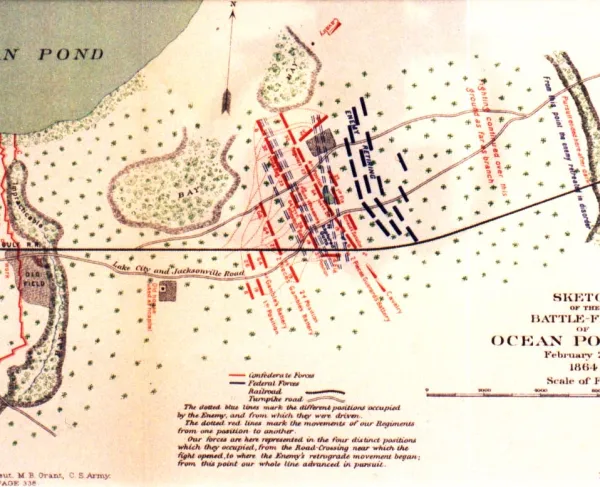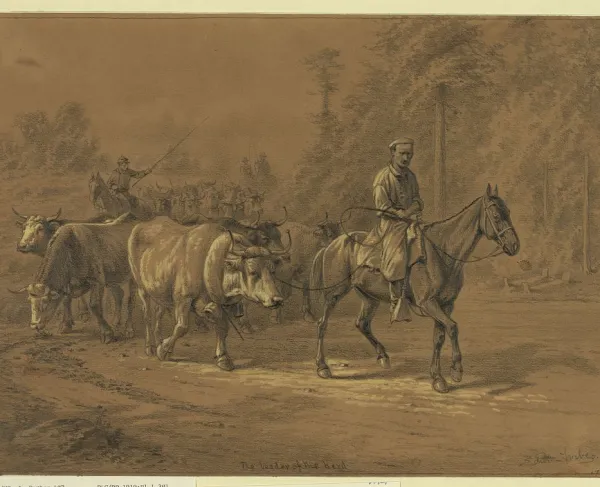10 Facts: The Battle of Olustee

-
The Battle was never supposed to happen.
The Union forces that captured Jacksonville, Florida were ordered to remain in the Jacksonville area to secure it from Confederate forces. However, Union Brigadier General Truman Seymour disobeyed orders and marched towards Tallahassee. During the march along the Florida, Atlantic and Gulf Central Railroad the Union Forces met entrenched Confederate regiments, resulting in a pitched battle.
-
Brigadier General Truman Seymour greatly underestimated the strength of the Confederate forces at Olustee.
Seymour believed that his Union contingent had encountered small bands of Florida militia and slowly committed the regiments under his command to battle. This was the result of Seymour’s previous successful raids against small pockets of Florida militia which had built up his confidence that there was no serious Confederate threat in Florida.
-
African Americans soldiers helped to stall the Confederate attacks on the retreating Union army, which prevented the total collapse of the retreating Union army.
The famed 54th Massachusetts Volunteer Infantry Regiment along with the 35th USCT Regiment held the line against a small group of Confederates who had counterattacked the rear of the retreating Union army. Eventually, the Confederate counterattack was repulsed, and the Union army successfully withdrew.
-
The fighting was so intense that the Confederate regiments ran out of ammunition for a period.
The Confederate regiments under the command of Brigadier General Joseph Finegan had to rely on the reinforcements under Confederate General Alfred H. Colquitt to arrive to finally push the Union forces off the field. The Confederate soldiers under Finegan’s command held the line for so long that they ran out of ammunition and still remained in position until they were relieved by Colquitt’s reinforcements who provided ammunition to the undersupplied soldiers.
-
The Battle of Olustee was extremely costly for the Union.
Despite this battle being one of the only major engagements in Florida during the war, it was indeed one of the bloodiest in terms of casualties. The Union forces in Olustee suffered 34% of their total soldiers being either killed, wounded, missing, or captured. Out of 5,500 Union soldiers that fought at Olustee, only 3,639 men escaped completely unharmed.
-
The 54th Massachusetts Volunteer Infantry Regiment helped save stranded wounded Union soldiers.
After the battle concluded and each combatant withdrew, a train transporting wounded Union soldiers broke down. Rather than leaving the wounded men stranded and vulnerable to capture, the 54th Massachusetts Regiment marched towards the broken train and tied ropes around the locomotive to manually pull it across the railroad. The men of the 54th pulled the train of wounded soldiers for three miles until they acquired horses to help pull the train another ten miles to Jacksonville.
-
The Union campaign in Florida was mainly to cut off food supplies for the Confederate army.
The Union landing at Jacksonville was strategically chosen as its location was along Confederate supply lines for both beef and salt. With the capture of Jacksonville, the Union forces were able to interrupt supply lines and successfully prevent Confederate food items from getting into Confederate hands.
-
The Battle of Olustee did not remove Union presence from Florida, it just prevented further expeditions inland.
Even though the Confederate forces drove Seymour’s Union expedition back to Jacksonville, the Union remained in control of Jacksonville until the end of the war. Furthermore, Union landings on Florida’s Gulf coast saw greater success and effectively furthered the Union’s grasp on the state and its control of sea routes.
-
The Union defeat at Olustee and the retreat to Jacksonville established Jacksonville as a haven for escaped slaves.
The Union defeat at Olustee consolidated the remaining Union soldiers around the Jacksonville area. This prevented the Union holdings from being too spread-out and thus too vulnerable to attack. By withdrawing to Jacksonville for the rest of the war, the Union army facilitated the emancipation of any enslaved person if they could reach the Union lines at Jacksonville. The further Union landings in Florida created more pockets of safety for slaves to escape to.
-
President Lincoln wanted Florida to become reintegrated with the Union in time for the 1864 Election.
In addition to cutting supply lines, the Union army was sent to Florida with the hopes of gathering Union supporters, who were spread out in enclaves throughout the state, to establish a Federal-Friendly government that was to be recognized by Washington DC. However, the Union defeat at Olustee worried President Lincoln about such ambitions and he then gave up attempts to push deep into Florida.





